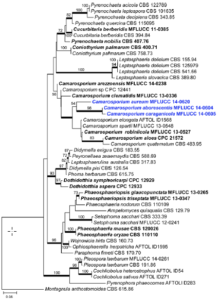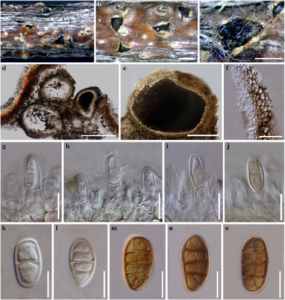Camarosporium aborescentis Phukhamsakda, Bulgakov & K.D. Hyde.
Index Fungorum number: IF631612, Facesoffungi number: FoF00406; Fig. 2
Etymology – The specific epithet arborescentis refers to the host species Colutea arborescens and latin entis means residing that reference to the host from which the fungus was first collected.
Holotypus – MFLU 14–0793
Saprobic on dead branch of Colutea arborescens L. Sexual morph Undetermined. Asexual morph Conidiomata 490 – 770 μm diam., 350 – 600 μm high, pycnidial, immersed, erumpent at maturity, solitary to gregarious, scattered, unilocular, dark brown, papillate ostiole. Pycnidial wall 32 – 54 μm (– 70 μm at apex), multi – layered, with 4 – 6 layers, comprising of brown walled cells of textura angularis. Conidiophores reduced to conidiogenous cells. Conidiogenous cells enteroblastic with percurrent annelidic, discrete, doliiform, hyaline, brown when mature, smooth – walled, formed from the inner layer of pycnidium wall. Conidia 12 – 25 × 5 – 13 μm (x̄ = 20.3 × 9 μm, n = 50), oblong, ellipsoid, straight or rarely slightly curved, narrowly rounded at both ends, muriform, with 1 – 3 transverse septa, and 1 – 4 longitudinal septa, initially hyaline, pale brown to brown at maturity, smooth-walled.
Culture characters – Colonies on PDA reaching 25 – 33 mm diam. after 1 week at 16 °C, later with dense mycelium, circular, fimbriate, margin rough, white at first, olive-green after 5 days in the centre of the colony, convex with papillate on the surface, without aerial mycelium. Hyphae septate, branched, hyaline.
Material examined – RUSSIA, Rostov Province, Rostovna- Donu, Badia Tega, Botanical Garden of Southern Federal University, Systematic Arboretum, on dead twigs of Colutea arborescens L. (Fabaceae), 8 May 2014, T. Bulgakov T44 (MFLU 14–0793, holotype); ex-type living culture, MFLUCC 14–0604. GenBank ITS: KP711377; LSU: KP711378; SSU: KP711379.
Notes – Our collection is morphologically similar to Camarosporium feurichii which has erumpent, black conidiomata and brown, smooth-walled, oblong, 3 transverse septa conidia, usually with one longitudinal septum (Eille and Eille 1985). Molecular data analyses of combined SSU, LSU and ITS sequence data (Fig. 1) show our strain cluster with Camarosporium sensu stricto which is a distinct lineage in Pleosporinae, Pleosporales (Wijayawardene et al. 2014).

Fig. 1 Phylogram generated from Maximum likelihood (RAxML) analysis based on combined LSU, SSU and ITS sequence data of Pleosporales. Maximum likelihood bootstrap support values greater than 50 % are indicated above or below the nodes, and branches with Bayesian posterior probabilities greater than 0.95 are given in bold. The ex-types (reference strains) are in bold; the new isolates are in blue. The tree is rooted with Montagnula anthostomoides CBS 615.86

Fig. 2 Camarosporium aborescentis (holotype) a, b Conidiomata on surface of twigs c Side view of conidiomata erumpent on surface of host d Vertical section of multi-locular conidiomata e Vertical section of unilocular conidiomata f Part of pycnidial wall g – j Conidiogenous cells and developing conidia k – l Immature conidia m – o Conidia at maturity. Scale bars: b – d =500 μm, e = 200 μm, f = 50 μm, g – o = 10 μm.
